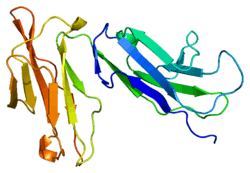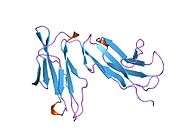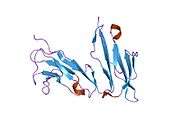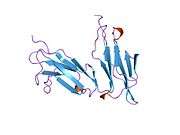FCGR2B
Fc fragment of IgG receptor IIb (coded by FCGR2B gene) is a low affinity inhibitory receptor for the Fc region of immunoglobulin gamma (IgG). FCGR2B participates in the phagocytosis of immune complexes and in the regulation of antibody production by B lymphocytes.[5]
Structure
There are two major forms of FCGR2B existing (FCGR2B1 and FCGR2B2) and they are created by mRNA splicing mechanism, which results in the inclusion (FCGR2B1) or exclusion (FCGR2B2) of the C1 exon sequence. The presence of the C1 exon sequence (in FCGR2B1) results in tethering to the membrane of B cells, whereas its absence (in FCGR2B2) allows fast internalization of the receptor in myeloid cells. Both forms contain the Immunoreceptor Tyrosine-based Inhibitory Motif (ITIM) in their cytoplasmic regions. The extracellular domains are 95% identical to the domains of FCGR2A and almost completely identical to the FCGR2C (the other members of CD32 family).[6]
Expression
FCGR2B1 is highly expressed by B cells, and its mRNA has also been identified at lower levels on monocytes. FCGR2B2 is highly expressed on basophils and at low levels on monocytes. Cytokine regulation of the expression is positive in the case of IL-10 and IL-6 and negative in the case of TNF-α, C5a and IFN-γ.[6]
Function
The receptor inhibits the functions of activating FcγRs, such as phagocytosis and pro-inflammatory cytokine release, mainly by clustering of FCGR2B with different activating FCGR receptors or with the BCR by immune complexes.[7][6]
The phosphorylated ITIM of FcγRIIB recruits the inositol phosphatases SHIP1 and SHIP2, which inhibit the Ras activation, downregulate MAPK activity and reduce PLCγ function and lead to decreased activation of PKC. Inhibition of the MAP kinase pathway, together with the anti-apoptotic kinase Akt can negatively affect proliferation and survival of the cells.[6]
FCGR2B regulates B cell activation by increasing the BCR activation threshold and suppressing B cell mediated antigen presentation to T cells through the ITIM-dependent inhibitory mechanism.[7] Ligation of FCGR2B on B cells downregulates antibody production, prevents the membrane organization of BCR and CD19 and promotes apoptosis. Co-ligation of FCGR2B on dendritic cells inhibits maturation and blocks cell activation.[6] The negative regulatory role of the FCGRIIB molecule is not limited to BCR-induced B-cell activation, but is also functional on other B-cell activation pathways mediated by CD40 and IL-4.[8]
FCGR2B expression on follicular dendritic cells (FDCs) is important for capturing the antigen-containing immune complexes which are essential for the germinal centre response.[7]
FCGR2B is present on non-leukocyte cells including airway smooth muscle and liver sinusoidal endothelial cells, where small immune complexes are internalized inhibiting the pro-inflammatory signalling.[6]
Autoimmunity
FCGR2B is one of the genes thought to influence susceptibility to several autoimmune diseases in humans. Its decreased function is associated with systemic lupus erythematosus, rheumatoid arthritis, Goodpasture's disease, multiple sclerosis and others.[7]
FCGR2B may be a target for monoclonal antibody therapy for autoimmune diseases as well as malignancies.[7][9][10]
See also
References
- GRCh38: Ensembl release 89: ENSG00000072694 - Ensembl, May 2017
- GRCm38: Ensembl release 89: ENSMUSG00000026656 - Ensembl, May 2017
- "Human PubMed Reference:". National Center for Biotechnology Information, U.S. National Library of Medicine.
- "Mouse PubMed Reference:". National Center for Biotechnology Information, U.S. National Library of Medicine.
- "FCGR2B Fc fragment of IgG receptor IIb [Homo sapiens (human)] - Gene - NCBI". www.ncbi.nlm.nih.gov. Retrieved 2019-06-14.
- Anania JC, Chenoweth AM, Wines BD, Hogarth PM (2019-03-19). "The Human FcγRII (CD32) Family of Leukocyte FcR in Health and Disease". Frontiers in Immunology. 10: 464. doi:10.3389/fimmu.2019.00464. PMC 6433993. PMID 30941127.
- Smith, Kenneth G. C.; Clatworthy, Menna R. (2010-08-06). "Erratum: FcγRIIB in autoimmunity and infection: evolutionary and therapeutic implications". Nature Reviews Immunology. 10 (9): 674. doi:10.1038/nri2821. ISSN 1474-1733.
- Horejs-Hoeck J, Hren A, Mudde GC, Woisetschläger M (July 2005). "Inhibition of immunoglobulin E synthesis through Fc gammaRII (CD32) by a mechanism independent of B-cell receptor co-cross-linking". Immunology. 115 (3): 407–15. doi:10.1111/j.1365-2567.2005.02162.x. PMC 1782155. PMID 15946258.
- Rankin CT, Veri MC, Gorlatov S, Tuaillon N, Burke S, Huang L, et al. (October 2006). "CD32B, the human inhibitory Fc-gamma receptor IIB, as a target for monoclonal antibody therapy of B-cell lymphoma". Blood. 108 (7): 2384–91. doi:10.1182/blood-2006-05-020602. PMID 16757681.
- Zhou P, Comenzo RL, Olshen AB, Bonvini E, Koenig S, Maslak PG, et al. (April 2008). "CD32B is highly expressed on clonal plasma cells from patients with systemic light-chain amyloidosis and provides a target for monoclonal antibody-based therapy". Blood. 111 (7): 3403–6. doi:10.1182/blood-2007-11-125526. PMC 2275009. PMID 18216299.
Further reading
- Tsuchiya N, Kyogoku C (August 2005). "Role of Fc gamma receptor IIb polymorphism in the genetic background of systemic lupus erythematosus: insights from Asia". Autoimmunity. 38 (5): 347–52. doi:10.1080/08916930500123926. PMID 16227149.
- Engelhardt W, Geerds C, Frey J (June 1990). "Distribution, inducibility and biological function of the cloned and expressed human beta Fc receptor II". European Journal of Immunology. 20 (6): 1367–77. doi:10.1002/eji.1830200624. PMID 2142460.
- Seki T (1989). "Identification of multiple isoforms of the low-affinity human IgG Fc receptor". Immunogenetics. 30 (1): 5–12. doi:10.1007/BF02421463. PMID 2526077.
- Brooks DG, Qiu WQ, Luster AD, Ravetch JV (October 1989). "Structure and expression of human IgG FcRII(CD32). Functional heterogeneity is encoded by the alternatively spliced products of multiple genes". The Journal of Experimental Medicine. 170 (4): 1369–85. doi:10.1084/jem.170.4.1369. PMC 2189488. PMID 2529342.
- Stuart SG, Simister NE, Clarkson SB, Kacinski BM, Shapiro M, Mellman I (December 1989). "Human IgG Fc receptor (hFcRII; CD32) exists as multiple isoforms in macrophages, lymphocytes and IgG-transporting placental epithelium". The EMBO Journal. 8 (12): 3657–66. doi:10.1002/j.1460-2075.1989.tb08540.x. PMC 402048. PMID 2531080.
- Stengelin S, Stamenkovic I, Seed B (April 1988). "Isolation of cDNAs for two distinct human Fc receptors by ligand affinity cloning". The EMBO Journal. 7 (4): 1053–9. doi:10.1002/j.1460-2075.1988.tb02913.x. PMC 454434. PMID 3402431.
- Engelhardt W, Matzke J, Schmidt RE (April 1995). "Activation-dependent expression of low affinity IgG receptors Fc gamma RII(CD32) and Fc gamma RIII(CD16) in subpopulations of human T lymphocytes". Immunobiology. 192 (5): 297–320. doi:10.1016/s0171-2985(11)80172-5. PMID 7649565.
- D'Ambrosio D, Hippen KL, Minskoff SA, Mellman I, Pani G, Siminovitch KA, Cambier JC (April 1995). "Recruitment and activation of PTP1C in negative regulation of antigen receptor signaling by Fc gamma RIIB1". Science. 268 (5208): 293–7. Bibcode:1995Sci...268..293D. doi:10.1126/science.7716523. PMID 7716523.
- Warmerdam PA, van den Herik-Oudijk IE, Parren PW, Westerdaal NA, van de Winkel JG, Capel PJ (March 1993). "Interaction of a human Fc gamma RIIb1 (CD32) isoform with murine and human IgG subclasses". International Immunology. 5 (3): 239–47. doi:10.1093/intimm/5.3.239. PMID 8466861.
- Bewarder N, Weinrich V, Budde P, Hartmann D, Flaswinkel H, Reth M, Frey J (September 1996). "In vivo and in vitro specificity of protein tyrosine kinases for immunoglobulin G receptor (FcgammaRII) phosphorylation". Molecular and Cellular Biology. 16 (9): 4735–43. doi:10.1128/MCB.16.9.4735. PMC 231474. PMID 8756631.
- Sandilands GP, MacPherson SA, Burnett ER, Russell AJ, Downie I, MacSween RN (June 1997). "Differential expression of CD32 isoforms following alloactivation of human T cells". Immunology. 91 (2): 204–11. doi:10.1046/j.1365-2567.1997.00241.x. PMC 1363848. PMID 9227318.
- De SK, Venkateshan CN, Seth P, Gajdusek DC, Gibbs CJ (March 1998). "Adenovirus-mediated human immunodeficiency virus-1 Nef expression in human monocytes/macrophages and effect of Nef on downmodulation of Fcgamma receptors and expression of monokines". Blood. 91 (6): 2108–17. doi:10.1182/blood.V91.6.2108. PMID 9490697.
- Metes D, Ernst LK, Chambers WH, Sulica A, Herberman RB, Morel PA (April 1998). "Expression of functional CD32 molecules on human NK cells is determined by an allelic polymorphism of the FcgammaRIIC gene". Blood. 91 (7): 2369–80. doi:10.1182/blood.V91.7.2369. PMID 9516136.
- Sondermann P, Huber R, Jacob U (March 1999). "Crystal structure of the soluble form of the human fcgamma-receptor IIb: a new member of the immunoglobulin superfamily at 1.7 A resolution". The EMBO Journal. 18 (5): 1095–103. doi:10.1093/emboj/18.5.1095. PMC 1171201. PMID 10064577.
- Muraille E, Bruhns P, Pesesse X, Daëron M, Erneux C (April 2000). "The SH2 domain containing inositol 5-phosphatase SHIP2 associates to the immunoreceptor tyrosine-based inhibition motif of Fc gammaRIIB in B cells under negative signaling". Immunology Letters. 72 (1): 7–15. doi:10.1016/S0165-2478(00)00162-0. PMID 10789675.
- Pricop L, Redecha P, Teillaud JL, Frey J, Fridman WH, Sautès-Fridman C, Salmon JE (January 2001). "Differential modulation of stimulatory and inhibitory Fc gamma receptors on human monocytes by Th1 and Th2 cytokines". Journal of Immunology. 166 (1): 531–7. doi:10.4049/jimmunol.166.1.531. PMID 11123333.
- Lyden TW, Robinson JM, Tridandapani S, Teillaud JL, Garber SA, Osborne JM, et al. (March 2001). "The Fc receptor for IgG expressed in the villus endothelium of human placenta is Fc gamma RIIb2". Journal of Immunology. 166 (6): 3882–9. doi:10.4049/jimmunol.166.6.3882. PMID 11238632.
- Bharadwaj D, Mold C, Markham E, Du Clos TW (June 2001). "Serum amyloid P component binds to Fc gamma receptors and opsonizes particles for phagocytosis". Journal of Immunology. 166 (11): 6735–41. doi:10.4049/jimmunol.166.11.6735. PMID 11359830.
- Jessup CF, Ridings J, Ho A, Nobbs S, Roberton DM, Macardle P, Zola H (July 2001). "The Fc receptor for IgG (Fc gamma RII; CD32) on human neonatal B lymphocytes". Human Immunology. 62 (7): 679–85. doi:10.1016/S0198-8859(01)00257-9. PMID 11423173.
External links
- FCGR2B+protein,+human at the US National Library of Medicine Medical Subject Headings (MeSH)
This article incorporates text from the United States National Library of Medicine, which is in the public domain.







